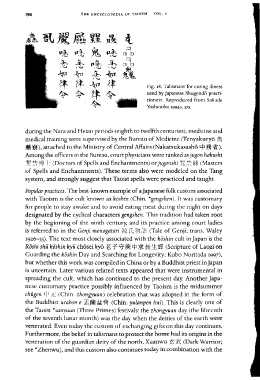Page 234 - The Encyclopedia of Taoism v1_A-L
P. 234
194 THE ENCYCLOPEDIA OF TAOISM VOL. I
~ ;\'
It .B ~: t
~
~J.~ "',t ~ %- q b
,"-'
'q
-l-. 4-. ~~- ~ p 0
.-.:.. ,~ , '-.J IV"
~ ~ .-}-. ~ A
. '"
~ rt ~\:l 4 Fig. 18. Talismans for curing illness
/'.~ ~ A used by Japanese Shugendo practi-
-'t -:: Tt -:z tioners. Reproduced from Sakade
4'- Yoshinobu 1994a, 375.
during the Nara and Heian periods (eighth to twelfth centuries), medicine and
medical training were supervised by the Bureau of Medicine (Tenyakuryo ~
~~), attached to the Ministry of Central Affairs (Nakatsukasasho $f1}1IiI').
Among the officers in the Bureau, court physicians were ranked as jugon hakushi
~ ~J~ tJJ: I: (Doctors of Spells and Enchantments) or jugonshi ~ ~J~ Olli (Masters
of Spells and Enchantments). These terms also were modeled on the Tang
system! and strongly suggest that Taoist spells were practiced and taught.
Popular practices. The best-known example of aJapanese folk custom associated
with Taoism is the cult known as koshin (Chin. *gengshen). It was customary
for people to stay awake and to avoid eating meat during the night on days
designated by the cyclical characters gengshen. This tradition had taken root
by the beginning of the ninth century, and its practice among court ladies
is referred to in the Genji monogatari llht l\: t~J ;ilf (Tale of Genji; trans. Waley
I926-33). The text most closely associated with the koshin cult in Japan is the
Roshi shu koshin kyu. chosei kyo ~.:r: ~ ~ $ * ~ 1:~~ (Scripture of Laozi on
Guarding the koshin Day and Searching for Longevity; Kubo Noritada I997),
but whether this work was compiled in China or by a Buddhist priest inJapan
is uncertain. Later various related texts appeared that were instrumental in
spreading the cult, which has continued to the present day. Another Japa-
nese customary practice possibly influenced by Taoism is the midsummer
chugen 'I' JL: (Chin. zhongyuan) celebration that was adopted in the form of
the Buddhist urabon-e ~ il '6l;: Wf (Chin. yulanpen hui). This is clearly one of
the Taoist *sanyuan (Three Primes) festivals: the zhongyuan day (the fifteenth
of the seventh lunar month) was the day when the deities of the earth were
venerated. Even today the custom of exchanging gifts on this day continues.
Furthermore, the belief in talismans to protect the home had its origins in the
veneration of the guardian deity of the north. Xuanwu K:fr~ (Dark Warrior;
see *Zhenwu), and this custom also continues today in combination with the

